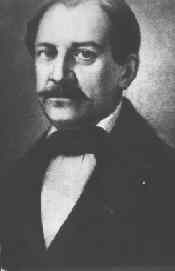The directory «Plots»
Negruzzi Costache
(1808—1868)

Negruzzi Costache is considered by Manolescu N. one of the most important Romanian writers. He is the son of Negrut Dinu, an educated land-owner, preoccupied to offer his son a good education. A passionate reader in more languages, around 13 years old he begin to translate. During the riot from 1821 his family repudiates at Chisinau. Here in 1822 he knows the Russian poet Puschin with whom he was friend. Returned in Moldavia he becomes a public personality, occupying important jobs (deputy of Iassy). The enters the progresist movements in Iassy, begins to publish. He was exiled between 1937-1838 at his domain in Trifesti because of "literary sins" (the article Vandalism). The year 1940 represents an important date in his life: he was appointed the director of the Schools' Eforie from Moldavia; he becomes an assiduous contributor of Dacia literara in which pages he publishes the short-story Alex Lapusneanu. He was appointed director of the National Theatre (with Kogalniceanu and Alecsandri). In 1844 the supports the appearance of the magazine Propasire. In 1853 he writes a periodical Saptamana. foaie sateasca with an important role in the dissemination of culture in the villages. His work includes verses, prose and theatre. He inaugurates in Romanian literature the epistolary genre by Negru pe Alb cycle. His Scrisori (Letters) contain: incursions trough history, geography (Plimbare, Ochire retrospectiva), his travelling journals (Pelerinagiu, B[ile de la Enes), the lampoon (Vandalism, Fiziologia provintislului) - includes a concise and humoristic portrait. Negruzzi's prose distinguishes by evoquing and anecdotic character. The short-story written during his youth Zoe, O alergare de cai - are written under the influence of the romantic readings. Memoralistic prose Cum am invatat romaneste (How I Learnt Romanian), Au mai patito si altii (Others Felt the Same) is remarkable by irony and humor. The historical fragments Alexandru Lapusneanu, Regele Poloniei si Domnul Moldovei (Poland's king and Moldavian Ruler), Sobieski si romanii acknowledged Negruzzi as the founds of the Romanian short-story. The short-story Alexandru Lapusneanu offers an example of mixing between classicism and romanticism in one single creation which forms the distinctive note of the Romanian literature during the cultural European movement from 1848. The short-story is romantic by the manner of concavity the main character's destiny by voluntary attitude of some characters, by the pantheism of gestures and by social-political conflict. It is classic by the profound psychological and typological observations by proportion and equilibrium of the comparison. The permanent coexistence of both the classic land the romantic element counties in the period from 1848.The Romanian romanticism reaches the climax by Eminescu's work which marked a contimation but also a huge change. German culture helped him to give up the model of the French romanticism. The classicism opened the way to realism.
Rumania, 1960, Costache Negruzzi
Moldova, 2002.10.23,  Chisinau. Constantin Negruzzi
Chisinau. Constantin Negruzzi
Moldova, 2008.04.12,  Chisinau. Constantin Negruzzi
Chisinau. Constantin Negruzzi
Moldova, 2002.10.23,  Constantin Negrutsi
Constantin Negrutsi